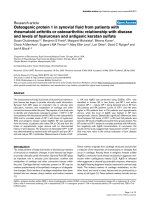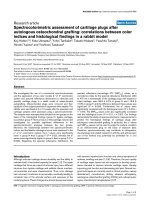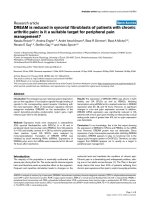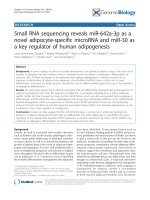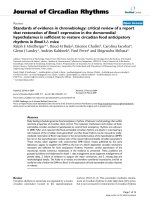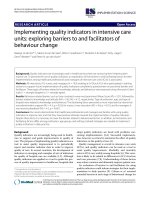Báo cáo y học: "Acute kidney injury in intensive care unit patients: a comparison between the RIFLE and the Acute Kidney Injury Network classifications" potx
Bạn đang xem bản rút gọn của tài liệu. Xem và tải ngay bản đầy đủ của tài liệu tại đây (193.45 KB, 8 trang )
Open Access
Available online />Page 1 of 8
(page number not for citation purposes)
Vol 12 No 4
Research
Acute kidney injury in intensive care unit patients: a comparison
between the RIFLE and the Acute Kidney Injury Network
classifications
José António Lopes
1
, Paulo Fernandes
1
, Sofia Jorge
1
, Sara Gonçalves
1
, António Alvarez
2
,
Zélia Costa e Silva
2
, Carlos França
2
and Mateus Martins Prata
1
1
Department of Nephrology and Renal Transplantation, Hospital de Santa Maria, Av. Prof. Egas Moniz, Lisboa 1649-035, Portugal
2
Department of Intensive Medicine, Hospital de Santa Maria, Av. Prof. Egas Moniz, Lisboa 1649-035, Portugal
Corresponding author: José António Lopes,
Received: 8 Jun 2008 Revisions requested: 25 Jul 2008 Revisions received: 29 Jul 2008 Accepted: 28 Aug 2008 Published: 28 Aug 2008
Critical Care 2008, 12:R110 (doi:10.1186/cc6997)
This article is online at: />© 2008 Lopes et al.; licensee BioMed Central Ltd.
This is an open access article distributed under the terms of the Creative Commons Attribution License ( />),
which permits unrestricted use, distribution, and reproduction in any medium, provided the original work is properly cited.
Abstract
Introduction Whether discernible advantages in terms of
sensitivity and specificity exist with Acute Kidney Injury Network
(AKIN) criteria versus Risk, Injury, Failure, Loss of Kidney
Function, End-stage Kidney Disease (RIFLE) criteria is currently
unknown. We evaluated the incidence of acute kidney injury and
compared the ability of the maximum RIFLE and of the maximum
AKIN within intensive care unit hospitalization in predicting
inhospital mortality of critically ill patients.
Methods Patients admitted to the Department of Intensive
Medicine of our hospital between January 2003 and December
2006 were retrospectively evaluated. Chronic kidney disease
patients undergoing dialysis or renal transplant patients were
excluded from the analysis.
Results In total, 662 patients (mean age, 58.6 ± 19.2 years;
392 males) were evaluated. AKIN criteria allowed the
identification of more patients as having acute kidney injury
(50.4% versus 43.8%, P = 0.018) and classified more patients
with Stage 1 (risk in RIFLE) (21.1% versus 14.7%, P = 0.003),
but no differences were observed for Stage 2 (injury in RIFLE)
(10.1% versus 11%, P = 0.655) and for Stage 3 (failure in
RIFLE) (19.2% versus 18.1%, P = 0.672). Mortality was
significantly higher for acute kidney injury defined by any of the
RIFLE criteria (41.3% versus 11%, P < 0.0001; odds ratio =
2.78, 95% confidence interval = 1.74 to 4.45, P < 0.0001) or
of the AKIN criteria (39.8% versus 8.5%, P < 0.0001; odds ratio
= 3.59, 95% confidence interval = 2.14 to 6.01, P < 0.0001).
The area under the receiver operator characteristic curve for
inhospital mortality was 0.733 for RIFLE criteria (P < 0.0001)
and was 0.750 for AKIN criteria (P < 0.0001). There were no
statistical differences in mortality by the acute kidney injury
definition/classification criteria (P = 0.72).
Conclusions Although AKIN criteria could improve the
sensitivity of the acute kidney injury diagnosis, it does not seem
to improve on the ability of the RIFLE criteria in predicting
inhospital mortality of critically ill patients.
Introduction
Multiple definitions have until recently been used for acute kid-
ney injury (AKI), and therefore the wide variation in definitions
has made it difficult to compare results across studies and
populations [1]. Recently, however, the Acute Dialysis Out-
come Initiative group proposed a classification for AKI – the
Risk, Injury, Failure, Loss of Kidney Function, and End-stage
Kidney Disease (RIFLE) classification – in order to have a uni-
form standard for diagnosing and classifying AKI [2]. The
standard defines three grades of severity – risk (Class R),
injury (Class I) and failure (Class F) – and two outcome
classes – loss of kidney function and end-stage kidney dis-
ease [2].
This classification system includes separate criteria for creati-
nine and urine output. A patient can fulfill the criteria through
changes in serum creatinine or changes in urine output, or
both. The criteria that lead to the worst possible classification
should be used. Class R is considered if there is an increase
of serum creatinine X1.5 or an urinary output < 0.5 ml/kg/hour
AKI: acute kidney injury; AKIN: Acute Kidney Injury Network; AuROC: area under the receiver operator characteristic; CI: confidence interval; ICU:
intensive care unit; OR: odds ratio; RIFLE: Risk, Injury, Failure, Loss of Kidney Function, End-stage Kidney Disease.
Critical Care Vol 12 No 4 Lopes et al.
Page 2 of 8
(page number not for citation purposes)
for 6 hours; Class I is considered if there is an increase of
serum creatinine X2 or an urinary output < 0.5 ml/kg/hour for
12 hours; and Class F is considered if there is an increase of
serum creatinine X3, or in patients with serum creatinine >4
mg/dl if there is an acute rise in serum creatinine of at least 0.5
mg/dl, or a urinary output < 0.3 ml/kg/hour for 24 hours, or
anuria for 12 hours (Table 1).
Several studies have demonstrated that the RIFLE criteria
have clinical relevance for the diagnosis of AKI, classifying the
severity of AKI and for monitoring the progression of AKI, as
well as having predictive ability for mortality in hospitalized
patients in general, and patients in the intensive care unit (ICU)
setting in particular [3-12]. Nevertheless, a more recent clas-
sification for AKI based on the RIFLE system has been pro-
posed by the Acute Kidney Injury Network (AKIN) [13]. This
new staging system (Table 2) differs from the RIFLE classifica-
tion as follows: it reduces the need for baseline creatinine but
does require at least two creatinine values within 48 hours;
AKI is defined as an abrupt (within 48 hours) reduction in kid-
ney function, currently defined as an absolute increase in
serum creatinine ≥0.3 mg/dl (≥26.4 μmol/l), a percentage
increase in serum creatinine ≥50% (1.5-fold from baseline), or
a reduction in urine output (documented oliguria < 0.5 ml/kg/
hour for > 6 hours); risk maps to Stage 1, but it also considers
an increase in serum creatinine ≥0.3 mg/dl (≥26.4 μmol/l);
injury and failure map to Stages 2 and 3, respectively; Stage 3
also includes patients who need renal replacement therapy
irrespective of the stage they are in at the time of renal replace-
ment therapy; and the two outcome classes loss and end-
stage kidney disease have been removed.
These modifications were based on the accumulating evi-
dence that small increases in serum creatinine are associated
with adverse outcomes, and on the variability inherent in com-
mencing renal replacement therapy and inherent to resources
in different populations and countries. Despite the AKIN crite-
ria possibly having greater sensitivity and specificity, it is cur-
rently unknown whether discernible advantages exist with one
approach towards definition and classification versus the
other.
Table 1
Risk, Injury, Failure, Loss of Kidney Function, End-stage Kidney Disease classification [2]
Class GFR criteria Urinary output criteria
Risk Serum creatinine × 1.5 or GFR decrease > 25% < 0.5 ml/kg/hour × 6 hours
Injury Serum creatinine × 2 or GFR decrease > 50% < 0.5 ml/kg/hour × 12 hours
Failure Serum creatinine × 3, GFR decrease > 75% or serum creatinine
≥4 mg/dl with an acute rise > 0.5 mg/dl
< 0.3 ml/kg/hour × 24 hours, or anuria × 12 hours
Loss Persistent acute renal failure = complete loss of kidney function
> 4 weeks
End-stage kidney disease End-stage kidney disease > 3 months
For conversion of creatinine expressed in conventional units to standard units, multiply by 88.4. Patients are categorized on serum creatinine or
urinary output, or both, and the criteria that lead to the worst classification are used. Glomerular filtration rate (GFR) criteria are calculated as an
increase of serum creatinine above the baseline serum creatinine level. When the baseline serum creatinine is unknown and there is no past
history of chronic kidney disease, serum creatinine is calculated using the Modification of Diet in Renal Disease formula for assessment of kidney
function [14], assuming a GFR of 75 ml/min/1.73 m
2
.
Table 2
Classification/staging system for acute kidney injury [13] modified from the Risk, Injury, Failure, Loss of Kidney Function, End-
stage Kidney Disease criteria [2]
Stage Serum creatinine criteria Urine output criteria
1 Increase in serum creatinine ≥0.3 mg/dl (≥26.4 μmol/l) or increase to ≥150% to
200% (1.5-fold to 2-fold) from baseline
< 0.5 ml/kg/hour for > 6 hours
2 Increase in serum creatinine to > 200% to 300% (> 2-fold to 3-fold) from
baseline
< 0.5 ml/kg/hour for > 12 hours
3
a
Increase in serum creatinine to > 300% (> 3-fold) from baseline, or serum
creatinine ≥4.0 mg/dl (≥354 μmol/l) with an acute increase of at least 0.5 mg/dl
(44 μmol/l)
< 0.3 ml/kg/hour for 24 hours, or anuria for 12 hours
Acute kidney injury is defined as an abrupt (within 48 hours) reduction in kidney function, currently defined as an absolute increase in serum
creatinine ≥0.3 mg/dl (≥26.4 μmol/l), a percentage increase in serum creatinine ≥50% (1.5-fold from baseline), or a reduction in urine output
(documented oliguria < 0.5 ml/kg/hour for > 6 hours).
a
Individuals who receive renal replacement therapy are considered to have met the criteria
of Stage 3 irrespective of the stage they are in at the time of renal replacement therapy.
Available online />Page 3 of 8
(page number not for citation purposes)
In the present study, we evaluated the incidence of AKI and
compared the ability of the maximum RIFLE and of the
maximum AKIN within ICU hospitalization in predicting inhos-
pital mortality of critically ill patients.
Materials and methods
The present study is retrospective, including all patients admit-
ted to the ICU of the Hospital de Santa Maria (Lisbon, Portu-
gal) between January 2003 and December 2006. Variables
such as age, gender, race, body weight, history of cardiovas-
cular disease (angina pectoris, myocardial infarction, cere-
brovascular disease, and diabetes mellitus), primary diagnosis,
Simplified Acute Physiology Score version II, vasopressor use,
need for mechanical ventilation or renal replacement therapy,
serum creatinine, urine output and outcome were collected
from the ICU database and patient medical charts.
Baseline serum creatinine values were unavailable and were
estimated by the Modification of Diet in Renal Disease equa-
tion [14], as recommended (assuming a lower limit of the nor-
mal baseline glomerular filtration rate of 75 ml/min/1.73 m
2
)
and previously applied [2,4,9]. In this ICU, serum creatinine is
determined at least once a day and urine output is recorded
hourly, for all patients. AKI was defined and classified by
means of the RIFLE criteria [2] (Table 1) and the AKIN criteria
[13] (Table 2). Patients were categorized on serum creatinine
or on urine output, or both, the criteria that led to the worst
classification were used, and the maximum AKIN and the max-
imum RIFLE within ICU hospitalization were reported. At least
two serum creatinine values within 48 hours were considered
to define AKIN stages. The maximum RIFLE was calculated
considering the maximum creatinine with reference to the
Modification of Diet in Renal Disease equation-estimated cre-
atinine, and the reference creatinine used for AKIN staging
was the lowest creatinine within a 48-hour timeframe.
Sepsis was classified in accordance with the American Col-
lege of Chest Physicians and the Society of Critical Care Med-
icine consensus [15]. The Simplified Acute Physiology Score
version II was used to evaluate illness severity, and was calcu-
lated based on the worst variables recorded during the first 24
hours of ICU admission [16]. Inhospital mortality was consid-
ered the outcome measure. Chronic kidney disease patients
on dialysis and renal transplant patients were excluded from
the analysis. Since this was a retrospective and observational
study that did not evaluate a specific therapeutic or prophylac-
tic intervention, institutional ethical approval was not required
according to our institution's guidelines.
Statistical analysis
Continuous variables are expressed as the mean ± standard
deviation, and categorical variables are presented as the per-
centage of the number of cases. Comparisons between RIFLE
classes or AKIN stages were performed using analysis of var-
iance and the chi-square test for continuous variables and cat-
egorical variables, respectively. Multivariate logistic regression
analysis was employed to evaluate the association between
RIFLE criteria and AKIN criteria with inhospital mortality. Model
fit was assessed by the goodness of-fit test, and discrimination
was assessed by the area under the receiver operator charac-
teristic (AuROC) curve.
Data are presented as odds ratios (ORs) with 95% confi-
dence intervals (CIs). A two-tailed P value < 0.05 was consid-
ered significant. Analysis was performed with the statistical
software package SPSS 15.0 for Windows (Produtos e
Serviços de Estatísticas, Lisboa, Portugal).
Results
During the study period 703 patients were admitted to the
ICU, but 41 of them were chronic kidney disease patients
undergoing dialysis and were excluded from the analysis.
None of the patients had received a renal transplant. A total of
662 patients (mean age, 58.6 ± 19.2 years; 392 males; 613
Caucasian; mean Simplified Acute Physiology Score version
II, 46.3 ± 18.6) were therefore evaluated. Patient baseline
characteristics are summarized in Tables 3 and 4.
Acute kidney injury stratified by the RIFLE and AKIN
criteria
AKI occurred in 43.8% of patients with a maximum RIFLE cat-
egory: risk in 14.7%, injury in 11% and failure in 18.1% (Table
5). According to AKIN criteria, AKI occurred in 50.4% of
patients – 21.1% with Stage 1, 10.1% with Stage 2 and
Table 3
Patient baseline characteristics
Variable Value
Mean age (years) 58.6 ± 19.2
Male (%) 59.2
Caucasian (%) 92.6
Mean body weight (kg) 74.2 ± 16.1
History of cardiovascular disease
a
(%) 53.2
Medical admission (%) 76.4
Sepsis
b
(%) 40.9
Baseline serum creatinine (μmol/l)
c
96.9 ± 37.2
Simplified Acute Physiology Score version II
d
46.3 ± 18.6
Vasopressors (%) 40
Need for mechanical ventilation (%) 84.7
Mean length of stay (days) 8.2 ± 6.5
a
Angina pectoris, myocardial infarction, cerebrovascular disease, and
diabetes mellitus.
b
Defined in accordance with the American College
of Chest Physicians and the Society of Critical Care Medicine
consensus [15].
c
Estimated by the Modification of Diet in Renal
Disease equation [14], assuming a lower limit of the normal baseline
glomerular filtration rate of 75 ml/min/1.73 m
2
.
d
Calculated based on
the worst variables recorded during the first 24 hours of admission
[16].
Critical Care Vol 12 No 4 Lopes et al.
Page 4 of 8
(page number not for citation purposes)
19.2% with Stage 3 (Table 5). AKIN criteria allowed the iden-
tification of more patients as having AKI (P = 0.018) and clas-
sified more patients with Stage 1 (risk in RIFLE) (P = 0.003);
however, no statistically significant differences were observed
for Stage 2 (injury in RIFLE) (P = 0.655) and for Stage 3 (fail-
ure in RIFLE) (P = 0.672).
Creatinine criteria led to a maximum RIFLE and a maximum
AKIN in 64.1% and 67.4% of patients, respectively, whereas
in almost 5% of patients it was the urine output criteria that led
to a maximum RIFLE and a maximum AKIN. Creatinine and
urine output criteria both led to a maximum RIFLE and a maxi-
mum AKIN in 30.3% and 27.8% of patients, respectively
(Table 6).
Seventy-nine AKI patients (27.2%), defined by the RIFLE clas-
sification based on creatinine and urine output criteria,
received renal replacement therapy. The requirement of renal
replacement therapy was higher in accordance with severity of
AKI, defined by the RIFLE classification based on creatinine
and urine output criteria (risk, 2%; injury; 12.3%; failure,
56.7%; P < 0.0001; AuROC curve = 0.829), and either on
creatinine criteria (risk, 2%; injury, 13%; failure, 56.1%; P <
0.0001; AuROC curve = 0.818) or on urine output criteria
(risk, 0%; injury, 27.5%; failure, 77.6%; P < 0.0001; AuROC
curve = 0.787).
Mortality
The overall mortality was 24.3%, and mortality was signifi-
cantly higher for AKI patients as compared with non-AKI
Table 4
Patient baseline characteristics and the Risk, Injury, Failure, Loss of Kidney Function, End-stage Kidney Disease (RIFLE) criteria
Variable No acute kidney injury (n = 372) Risk (n = 97) Injury (n = 73) Failure (n = 120) P value
Mean age (years) 55 ± 19 64 ± 18 63 ± 15 61 ± 16 < 0.0001
Male (%) 55.6 65.9 63 62.5 0.252
Caucasian (%) 93 91.7 91.8 92.5 1.000
History of cardiovascular disease
a
(%) 48.4 63.9 61.6 54.2 0.023
Medical admission (%) 71.8 78.4 80.8 86.7 0.008
Sepsis
b
(%) 26.6 39.2 61.6 74.2 < 0.0001
Baseline serum creatinine (μmol/l)
c
86 ± 24 100 ± 42 107 ± 26 123 ± 50 < 0.0001
Simplified Acute Physiology Score version II
d
40 ± 15 48 ± 15 51 ± 18 62 ± 21 < 0.0001
Vasopressors (%) 21.5 48.5 63 76.7 < 0.0001
Need for mechanical ventilation (%) 83.6 85.6 86.3 86.7 1.000
Urine output (l)
e
2.2 ± 0.9 0.5 ± 0.2 0.9 ± 0.5 1.4 ± 1.1
Serum creatinine at maximum RIFLE 162 ± 35 235 ± 32 395 ± 54
Need for renal replacement therapy
% of patients 2 12.3 56.7 < 0.0001
Mean time (days) 5 ± 2 10 ± 8 9 ± 7 0.599
Mean length of stay (days) 7 ± 8 8 ± 6 9 ± 10 11 ± 12 0.009
Mortality 11 30.9 32.8 55 < 0.0001
Complete renal function recovery
f
74.6 73.5 55.6 0.053
a
Aangina pectoris, myocardial infarction, cerebrovascular disease, and diabetes mellitus.
b
Defined in accordance with the American College of
Chest Physicians and the Society of Critical Care Medicine consensus [15].
c
Estimated by the Modification of Diet in Renal Disease equation
[14], assuming a lower limit of the normal baseline glomerular filtration rate of 75 ml/min/1.73 m
2
.
d
Calculated based on the worst variables
recorded during the first 24 hours of admission [16].
e
At maximum RIFLE (6-hour urine output for risk, 12-hour urine output for injury, and 24-hour
urine output for failure).
f
If the patient returned to their baseline classification within the RIFLE criteria [2].
Table 5
Incidence of acute kidney injury stratified by the Risk, Injury,
Failure, Loss of Kidney Function, End-stage Kidney Disease
(RIFLE) and the Acute Kidney Injury Network (AKIN) definition/
classification schemes
RIFLE classification AKIN classification
None 372 (56.2%) None 328 (49.5%)
Risk 97 (14.7%) Stage 1 140 (21.1%)
Injury 73 (11%) Stage 2 67 (10.1%)
Failure 120 (18.1%) Stage 3 127 (19.2%)
Any category 290 (43.8%) Any stage 334 (50.4%)
Available online />Page 5 of 8
(page number not for citation purposes)
patients, as follows: AKI defined by any of the RIFLE criteria
(41.3% versus 11%, P < 0.0001; OR = 2.78, 95% CI = 1.74
to 4.45, P < 0.0001) or AKIN criteria (39.8% versus 8.5%, P
< 0.0001; OR = 3.59, 95% CI = 2.14 to 6.01, P < 0.0001)
(Tables 7 and 8).
The analysis was repeated using the RIFLE or AKIN classifica-
tion either based only on creatinine criteria or only on urine out-
put criteria. AKI defined by any of the criteria was associated
with mortality (RIFLE creatinine, OR = 2.68, 95% CI = 1.69 to
4.25, P < 0.0001; AKIN creatinine, OR = 3.38, 95% CI = 2.05
to 5.57, P < 0.0001; RIFLE urine output, OR = 2.06, 95% CI
= 1.24 to 3.42, P = 0.005; AKIN urine output, OR = 1.9, 95%
CI = 1.16 to 3.14, P = 0.01). RIFLE classes and AKIN stages
based on creatinine criteria predicted mortality – whereas
when the maximum RIFLE and the maximum AKIN were based
on urine output criteria, only Class F and Stage 3 were inde-
pendently associated with mortality (Table 8).
When considering both creatinine and urine output criteria,
the AuROC curve for inhospital mortality was 0.733 for RIFLE
criteria (P < 0.0001) and 0.750 for AKIN criteria (P < 0.0001)
(Figures 1 and 2). There were no statistically significant differ-
ences in mortality by the AKI definition/classification criteria (P
= 0.72).
The AuROC curve for inhospital mortality was 0.729 for RIFLE
creatinine (P < 0.0001) and was 0.745 for AKIN creatinine (P
< 0.0001), whereas the AuROC curve was 0.619 (P <
0.0001) for RIFLE urine output and was 0.612 for AKIN urine
output (P < 0.0001).
Discussion
We conducted a single-center study with 662 ICU patients to
compare the new recently released definitions/classifications
for AKI – the RIFLE system and the AKIN system.
We confirmed that the RIFLE system allows the identification
and classification of a significant proportion of ICU patients as
having some degree of AKI, and predicts inhospital mortality.
These findings have also been reported in a variety of ICU
patients [3,5-12].
Nevertheless, a more recent classification for AKI based on
the RIFLE system has been proposed by the AKIN workgroup
[13]. This new staging system differs from RIFLE as follows: it
reduces the need for a baseline creatinine value but does
require at least two creatinine values within 48 hours; AKI is
defined as an abrupt (within 48 hours) reduction in kidney
function, currently defined as an absolute increase in serum
creatinine ≥0.3 mg/dl (≥26.4 μmol/l), a percentage increase in
serum creatinine ≥50% (1.5-fold from baseline), or a reduction
in urine output (documented oliguria < 0.5 ml/kg/hour for > 6
hours); risk maps to Stage 1, but it also considers an increase
in serum creatinine ≥0.3 mg/dl (≥26.4 μmol/l); injury and fail-
Table 6
Patients with acute kidney injury classified by creatinine criteria or urine output criteria, or both criteria
Creatinine (%) Urine output (%) Creatinine + urine output (%)
RIFLE classification
Risk 85.5 5.2 9.3
Injury 68.5 6.8 24.7
Failure 44.2 5 50.8
Any category 64.1 5.6 30.3
AKIN classification
Stage 1 87.1 3.6 9.3
Stage 2 73.1 7.5 19.4
Stage 3 42.5 4.7 52.8
Any category 67.4 4.8 27.8
Table 7
Mortality according to acute kidney injury stratified by the Risk,
Injury, Failure, Loss of Kidney Function, End-stage Kidney
Disease (RIFLE) and the Acute Kidney Injury Network (AKIN)
definition/classification schemes
RIFLE classification AKIN classification
None 11% None 8.5%
Risk 30.9% Stage 1 30.7%
Injury 32.8% Stage 2 32.8%
Failure 55% Stage 3 53.5%
Any category 41.3% Any stage 39.8%
Critical Care Vol 12 No 4 Lopes et al.
Page 6 of 8
(page number not for citation purposes)
ure map to Stages 2 and 3, respectively; Stage 3 also includes
patients who need renal replacement therapy irrespective of
the stage they are in at the time of renal replacement therapy;
and the two outcome classes loss and end-stage kidney dis-
ease have been removed. These modifications were based on
the accumulating evidence that small increases in serum cre-
atinine are associated with adverse outcomes, and on the var-
iability inherent in commencing renal replacement therapy and
inherent to resources in different populations and countries.
Despite the AKIN system possibly having greater sensitivity
and specificity, it is currently unknown whether discernible
advantages exist with one approach towards definition and
classification versus the other.
Table 8
Separate multivariate regression analysis for the Risk, Injury, Failure, Loss of Kidney Function, End-stage Kidney Disease (RIFLE)
and the Acute Kidney Injury Network (AKIN) classifications
Criteria Hospital mortality (odds ratio (95%
confidence interval))
P value Area under receiver operator characteristic
curve
RIFLE criteria (creatinine + urine output)
Risk 2.69 (1.49 to 4.88) 0.001 0.733
Injury 2.01 (1.03 to 3.89) 0.038
Failure 3.59 (2.01 to 6.42) < 0.0001
Any category 2.78 (1.74 to 4.45) < 0.0001
AKIN criteria (creatinine + urine output)
Stage 1 3.54 (1.97 to 6.37) < 0.0001 0.750
Stage 2 2.71 (1.33 to 5.53) 0.006
Stage 3 4.66 (2.49 to 8.73) < 0.0001
Any stage 3.59 (2.14 to 6.01) < 0.0001
RIFLE criteria (creatinine)
Risk 2.63 (1.46 to 4.75) 0.001 0.729
Injury 2.12 (1.1 to 4.08) 0.025
Failure 3.2 (1.8 to 5.7) < 0.0001
Any category 2.68 (1.69 to 4.25) < 0.0001
AKIN criteria (creatinine)
Stage 1 3.18 (1.79 to 5.64) < 0.0001 0.745
Stage 2 2.74 (1.35 to 5.56) 0.005
Stage 3 3.93 (2.12 to 7.28) < 0.0001
Any stage 3.38 (2.05 to 5.57) < 0.0001
RIFLE criteria (urine output)
Risk 1.3 (0.35 to 4.8) 0.689 0.619
Injury 0.83 (0.31 to 2.21) 0.711
Failure 3.26 (1.74 to 6.13) < 0.0001
Any category 2.06 (1.24 to 3.42) 0.005
AKIN criteria (urine output)
Stage 1 1.03 (0.3 to 3.58) 0.953 0.612
Stage 2 1.03 (0.35 to 2.99) 0.953
Stage 3 2.65 (1.45 to 4.84) 0.001
Any stage 1.9 (1.16 to 3.14) 0.01
Defined by both creatinine and urine output criteria or by creatinine criteria or by urine output criteria, including age, gender, race, history of
cardiovascular disease, medical admission, sepsis diagnosis, illness severity evaluated by Simplified Acute Physiology Score version II, and need
for vasopressors or for mechanical ventilation.
Available online />Page 7 of 8
(page number not for citation purposes)
In the present study, despite AKIN criteria allowing the identi-
fication of 6.6% more patients (50.4% versus 43.8%, P =
0.018) as having some degree of AKI and increasing the
number of patients classified as Stage 1 (risk in RIFLE) (from
14.7% to 21.1%, P = 0.003), no statistically significant differ-
ences in terms of inhospital mortality were found according to
AKI definition/classification criteria. In a recent report Bag-
shaw and colleagues utilized a large multicenter (120,123
patients, 57 ICUs) clinical database and found no statistically
significant differences in terms of incidence of AKI and inhos-
pital mortality by the RIFLE criteria or the AKIN criteria in the
first 24 hours after admission [17]. These observations sug-
gest that the proposed modifications for the RIFLE classifica-
tion, the most widely used definition of acute renal failure in
both the critical care and nephrology literature [18], do not
improve the ability of this classification in predicting inhospital
mortality of ICU patients.
As suggested by a North East Italian multicenter study on AKI,
classified by the RIFLE criteria, in 2,164 ICU patients [19], in
our analysis the serum creatinine criteria seemed to be a better
predictor of mortality than urine output. In fact, a rise in creati-
nine is an earlier sign of worsening renal function than oliguria.
In > 60% of our patients with AKI, the creatinine criteria led to
a worse RIFLE class or AKIN stage than urine output.
The current study has some limitations. First, it is a single-
center and retrospective study with a relatively small cohort of
patients. Second, we did not know the baseline serum creati-
nine level or the prevalence of chronic kidney disease (except
for those undergoing dialysis). Instead, we calculated an esti-
mate of baseline function using the Modification of Diet in
Renal Disease equation, as recommended (assuming a lower
limit of the normal baseline glomerular filtration rate of 75 ml/
min) and previously applied [2,4,9]. Third, despite having
hourly records of urine output, we did not have data regarding
additional factors that could influence urine output such as
diuretic therapy. Overall, we recognize that any biases would
influence both the RIFLE criteria and the AKIN criteria, and
thus would not significantly influence our conclusions.
Despite these limitations our study has several strengths. First,
it is the second study comparing the incidence of AKI, defined
by the RIFLE criteria and the AKIN criteria, and the prognostic
ability of these classifications in ICU patients. Second, the cre-
atinine criteria and urine output criteria were both used to
define and categorize AKI. Finally, we did not limit our analysis
to the first 24 hours of ICU admission, contrary to Bagshaw
and colleagues [17].
Conclusion
In summary, our results suggest that although the AKIN criteria
could improve the sensitivity of the AKI diagnosis, they do not
improve on the ability of the RIFLE criteria in predicting inhos-
pital mortality of critically ill patients. Taking into consideration
Figure 1
Area under the receiver operator characteristic (AuROC) curve for inhospital mortality for the Risk, Injury, Failure, Loss of Kidney Function, End-stage Kidney Disease criteria (P < 0.0001)Area under the receiver operator characteristic (AuROC) curve for
inhospital mortality for the Risk, Injury, Failure, Loss of Kidney Function,
End-stage Kidney Disease criteria (P < 0.0001).
Figure 2
Area under the receiver operator characteristic (AuROC) curve for inhospital mortality for the Acute Kidney Injury Network criteria (P < 0.0001)Area under the receiver operator characteristic (AuROC) curve for
inhospital mortality for the Acute Kidney Injury Network criteria (P <
0.0001).
Critical Care Vol 12 No 4 Lopes et al.
Page 8 of 8
(page number not for citation purposes)
the extensive validation of the RIFLE criteria in a higher number
of patients and heterogeneous groups of patients and cohorts
than any other widely accepted and applied definitions and
classifications for AKI [20-22], it is time for the utilization of the
RIFLE criteria in randomized controlled clinical trials as a sur-
rogate marker of clinically important outcome to establish spe-
cific interventions for prevention or attenuation of AKI.
Competing interests
The authors declare that they have no competing interests.
Authors' contributions
JAL, PF, SJ, SG and AA made substantial contributions to the
study concept and design, the acquisition of data, and the
analysis and interpretation of data. JAL, ZCeS, CF and MMP
were involved in drafting the manuscript and revising it criti-
cally for important intellectual content. All authors gave final
approval of the version to be published.
References
1. Bellomo R, Kellum JA, Ronco C: Defining acute renal failure:
physiological principles. Intensive Care Med 2004, 30:33-37.
2. Bellomo R, Ronco C, Kellum JA, Mehta RL, Palevsky P, Acute Dial-
ysis Quality Initiative workgroup: Acute renal failure – definition,
outcome measures, animal models, fluid therapy and informa-
tion technology needs: the Second International Consensus
Conference of the Acute Dialysis Quality Initiative (ADQI)
Group. Crit Care 2004, 8:R204-R212.
3. Hoste EA, Clermont G, Kersten A, Venkataraman R, Angus DC, De
Bacquer D, Kellum JA: RIFLE criteria for acute kidney injury are
associated with hospital mortality in critically ill patients: a
cohort analysis. Crit Care 2006, 10:R73-R82.
4. Uchino S, Bellomo R, Goldsmith D, Bates S, Ronco C: An assess-
ment of the RIFLE criteria for acute renal failure in hospitalized
patients. Crit Care Med 2006, 34:1913-1917.
5. Ahlstrom A, Kuitunen A, Peltonen S, Hynninen M, Tallgren M, Aal-
tonen J, Pettilä V: Comparison of 2 acute renal failure severity
scores to general scoring systems in the critically ill. Am J Kid-
ney Dis 2006, 48:262-268.
6. Lopes JA, Jorge S, Silva S, de Almeida E, Abreu F, Martins C, do
Carmo JA, Lacerda JF, Prata MM: An assessment of the RIFLE
criteria for acute renal failure following myeloablative autolo-
gous and allogeneic haematopoietic cell transplantation.
Bone Marrow Transplant 2006, 38:395. [letter]
7. Kuitunen A, Vento A, Suojaranta-Ylinen R, Pettilä V: Acute renal
failure after cardiac surgery: evaluation of the RIFLE
classification. Ann Thorac Surg 2006, 81:542-546.
8. Lin CY, Chen YC, Tsai FC, Tian YC, Jenq CC, Fang JT, Yang CW:
RIFLE classification is predictive of short-term prognosis in
critically ill patients with acute renal failure supported by extra-
corporeal membrane oxygenation. Nephrol Dial Transplant
2006, 21:2867-2873.
9. Guitard J, Cointault O, Kamar N, Muscari F, Lavayssière L, Suc B,
Ribes D, Esposito L, Barange K, Durand D, Rostaing L: Acute
renal failure following liver transplantation with induction
therapy. Clin Nephrol 2006, 65:103-112.
10. O'Riordan A, Wong V, McQuillan R, McCormick PA, Hegarty JE,
Watson AJ: Acute renal disease, as defined by the RIFLE crite-
ria, post-liver transplantation. Am J Transplant 2007,
7:
168-176.
11. Ostermann M, Chang RW: Acute kidney injury in the intensive
care unit according to RIFLE. Crit Care Med 2007,
35:1837-1843.
12. Lopes JA, Jorge S, Neves FC, Caneira M, da Costa AG, Ferreira
AC, Prata MM: An assessment of the rifle criteria for acute
renal failure in severely burned patients. Nephrol Dial
Transplant 2007, 22:285. [letter]
13. Mehta RL, Kellum JA, Shah SV, Molitoris BA, Ronco C, Warnock
DG, Levin A, Acute Kidney Injury Network: Acute Kidney Injury
Network: report of an initiative to improve outcomes in acute
kidney injury. Crit Care 2007, 11:R31.
14. Manjunath G, Sarnak MJ, Levey AS: Prediction equations to esti-
mate glomerular filtration rate: an update. Curr Opin Nephrol
Hypertens 2001, 10:785-792.
15. Levy MM, Fink MP, Marshall JC, Abraham E, Angus D, Cook D,
Cohen J, Opal SM, Vincent JL, Ramsay G, SCCM/ESICM/ACCP/
ATS/SIS: 2001 SCCM/ESICM/ACCP/ATS/SIS International
Sepsis Definitions Conference. Crit Care Med 2003,
4:1250-1256.
16. Le Gall JR, Lemeshow S, Saulnier F: A new Simplified Acute
Physiology Score (SAPS II) based on a European/North Amer-
ican multicenter study. JAMA 1993, 270:2957-2963.
17. Bagshaw SM, George C, Bellomo R, for the ANZICS Database
Management Committee: A comparison of the RIFLE and AKIN
criteria for acute kidney injury in critically ill patients. Nephrol
Dial Transplant 2008, 23:1569-1574.
18. Kellum JA, Bellomo R, Ronco C: Classification of acute kidney
injury using RIFLE: what's the purpose? Crit Care Med 2007,
35:1983-1984.
19. Cruz DN, Bolgan I, Perazella MA, Bonello M, de Cal M, Corradi V,
Polanco N, Ocampo C, Nalesso F, Piccinni P, Ronco C, for the
North East Italian Prospective Hospital Renal Outcome Survey on
Acute Kidney Injury (NEiPHROS-AKI) Investigators: North East
Italian Prospective Hospital Renal Outcome Survey on Acute
Kidney Injury (NEiPHROS-AKI): targeting the problem with the
RIFLE criteria. Clin J Am Soc Nephrol 2007, 2:418-425.
20. Bellomo R, Kellum JA, Ronco C: Defining and classifying acute
renal failure: from advocacy to consensus and validation of the
RIFLE criteria. Intensive Care Med 2007, 33:409-413.
21. Ricci Z, Cruz D, Ronco C: The RIFLE criteria and mortality in
acute kidney injury: a systematic review. Kidney Int 2008,
73:538-546.
22. Hoste EA, Schurgers M: Epidemiology of acute kidney injury:
how big is the problem? Crit Care Med 2008, 36:S146-S151.
Key messages
• The RIFLE criteria allowed the identification of 43.8% of
ICU patients as having some degree of AKI.
• The AKIN criteria could improve the sensitivity of the
AKI diagnosis but do not improve on the ability of the
RIFLE criteria in predicting inhospital mortality of ICU
patients.



